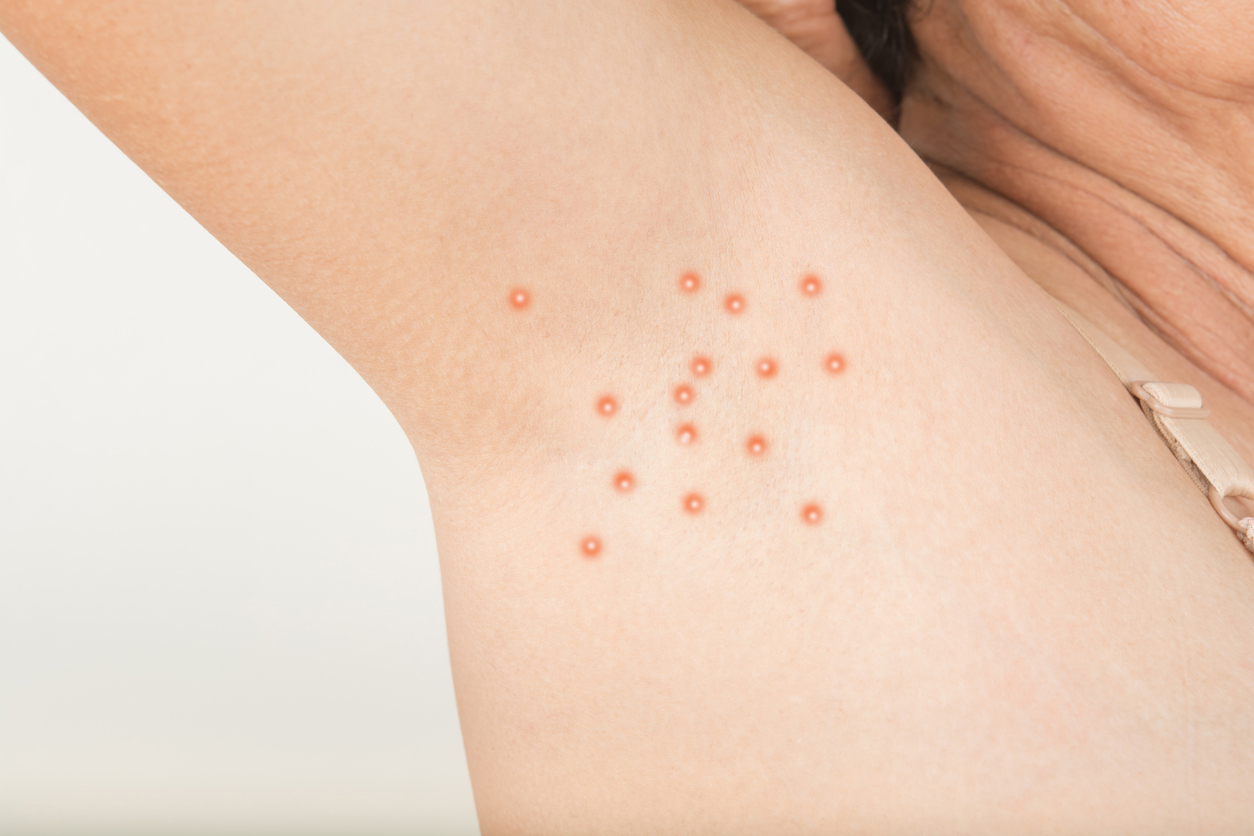How to Get Rid of Armpit Pimples
 How to Ged Rid of Armpit Pimples
How to Ged Rid of Armpit Pimples
While you might think that the red, angry bumps in your armpits are pimples caused by acne, they're most likely not! They might look like pimples, but there are a number of other reasons that you could be getting pimple-like bumps in your armpit. In this page, we'll talk about how to get rid of armpit pimples.
Heat Rash
Heat rash is the most common cause for underarm pimples.
What it looks like: Heat rash presents as a patch of red skin with white-head pimples or small clear boils. It will appear in moist areas of skin such as the underarms, groin, buttocks, or between other folds of skin.
What if feels like: Heat rash, also known as "prickly heat" and feels itchy, raw, prickly, or burns.
What causes it: In skin folds or other damp areas (like the underarm), perspiration can get trapped in skin if the skin can't "breathe." Sweat glands will continue to produce perspiration even when it can't be released through the skin. That buildup creates bumps and boils on the surface of the skin, which can then become infected.
How to get rid of it: First, take a look at your clothing. Some types of fabrics don't wick away moisture as well as others, so switching to more absorbent clothing can help draw out some of the moisture from your skin. Natural fibers are usually best. Second, clean the area regularly (at least once a day) with rubbing alcohol or everclear. It may burn at first, but it will disinfect the surface area and also dry out the skin and hopefully some of those pustules. DON'T try to pop the bumps, as that will lead to further infection and spread. Using an over-the-counter cortisone cream should also help to clear it up and ease the irritation. Finally, to prevent it in the future, you'll need to keep the area dry. Antiperspirants can be helpful with this, however, they contain aluminum compounds linked to Alzheimer's disease and hormonal imbalances, so some people choose to avoid them. If you're looking for a natural alternative, use a powder-based product, reapplied frequently throughout the day. This can be a simple corn starch, arrowroot powder or powdered clay. For something in a stick form, we make our organic Pit Putty Deodorant; it's saturated with powder to help absorb wetness. We recommend applying it frequently throughout the day on any area of skin on your body to help prevent heat rash. Of course, we like to be upfront with everyone and say that our product is not a drug, so it can't treat or prevent any medical conditions, and if you have a heat rash that persists, worsens, or is accompanied by other symptoms such as fever, do visit your doctor right away.
Folliculitis
What it looks like: Folliculitis is very similar to heat rash and it usually takes the trained eye of a doctor to differentiate the two. A folliculitis rash will usually have larger bumps and deeper infection. While heat rash usually shows up in areas of skin that are moist, folliculitis can spread to anywhere. You might end up with bumps that appear on your neck, torso, or elsewhere that may not even itch or hurt.
What it feels like: Itchy, but not typically as prickly or raw as heat rash. Large painful bumps may appear.
What causes it: Folliculitis can start out as heat rash, but with infection getting deeper in to the skin. Bumps may be larger.
How to get rid of it: Cleansing with alcohol and keeping the area dry with a powder-based product may clear it up. If your rash has spread from one part of your body to another, it means that you likely have systemic infection in your skin and need treatment from antibiotics. If you have a bumpy rash that doesn't clear up after a couple days, or is accompanied by other symptoms, visit a doctor for treatment.
Ingrown Hairs/Razor Burn
What it looks like: Red bumps
What it feels like: Can be painless, can be itchy or burn
What causes it: Follicles become irritated and swollen. Then, when hair starts to grow in, the hair can't escape and bumps form.
How to get rid of it: Sometimes the best healer is time. As the hair gets longer, it will eventually (usually) break out of the follicle and skin will normalize. Keep the area clean and dry as much as you can, by using a powder-based deodorant on your skin. Wiping with witch hazel can also help ease discomfort.
Hidradenitis suppurativa
What it looks like: Recurring large bumps or tracts under the skin
What it feels like: Painful, bruised feeling, burning
What causes it: There’s not a lot that we know about HS, or why some people get it and others don’t, but it can be difficult to manage. It’s unfortunately something that can happen even when using an antiperspirant or just a natural deodorant, just depending on what’s going on with your body. One study found that patients with HS had less "good" bacteria on their skin to fight off infective strains of bacteria.
How to get rid of it: You can try draining the boils with a hot compress. but they may need to be lanced or drained at a doctor’s office. Using an antiseptic could also be helpful — even something as simple as an alcohol-based hand sanitizer or witch hazel could be helpful to clean the skin and dry it out a bit. But I always advise getting in to a doctor to get it diagnosed and properly treated. You might need antibiotics to treat it — you don’t want it getting deeper in your skin and getting a systemic infection. It is important to get it treated because if it persists, it can cause scarring in the underarm.
Boils/Carbuncles
What it looks like: Painful bumps under the skin, sometimes coming to a head
What it feels like: Painful, burning, itching, bruised-feeling
What causes it: Boils are bumps that form when an infection grows in a follicle. Carbuncles are a series of boils that have grown together to form a pocket of infection. Sometimes they can appear randomly. Other times, there may be broken skin from rough deodorants, razor burn, or other skin irritation like intertrigo that then become infected.
How to get rid of it: You can try to drain the boil or carbuncle at home with a hot compress and gentle pressure. Keep the area as clean as possible and visit a doctor, as you may need to get it lanced or drained by a medical professional, and treated with antibiotics. Don't let an underarm boil or carbuncle persist, as it can lead to deeper infection and even become systemic (get in to your bloodstream.)
